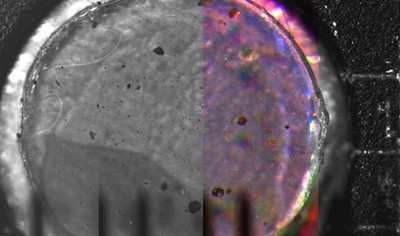Phoenix Continues To Dazzle From Red Planet Surface
A microscope on NASA's Mars Phoenix Lander has taken images of
dust and sand particles with the greatest resolution ever returned
from another planet. The mission's Optical Microscope observed
particles that had fallen onto an exposed surface, revealing grains
as small as one-tenth the diameter of a human hair.

"We have images showing the diversity of mineralogy on Mars at a
scale that is unprecedented in planetary exploration," said Michael
Hecht of NASA's Jet Propulsion Laboratory, Pasadena. He is the lead
scientist for Phoenix's Microscopy, Electrochemistry and
Conductivity Analyzer (MECA) instrument suite.
Meanwhile, Phoenix received commands Thursday to collect its
first soil sample to be delivered to a laboratory instrument on the
lander deck. Commands for that same activity sent on Wednesday did
not reach Phoenix because the orbiter intended for relaying the
transmission, NASA's Mars Odyssey, had put itself into a safe
standby mode shortly before the commands would have reached
Odyssey.
On Wednesday, the lander completed a back-up plan of activities
that had been sent previously, reported JPL's Chris Lewicki,
mission manager for Phoenix surface operations on the lander's 11th
Martian day. That plan included weather monitoring and additional
imaging for a high-resolution color panorama of the site.
The Optical Microscope images were taken June 3 of particles
that had collected on a sticky surface exposed during the Phoenix
landing and for five days after landing. "It's a first quick look,"
Hecht said. "This experiment was partly an insurance policy for
something to observe with the microscope before getting a soil
sample delivered by the arm, and partly a characterization of the
Optical Microscope. All the tools are working well."
Some of the particles might have come from inside the spacecraft
during the forceful events of landing, but many match expectations
for Martian particles. "We will be using future observations of
soil samples delivered by the Robotic Arm to confirm whether the
types of particles in this dustfall sample are also seen in samples
we can be certain are Martian in origin," Hecht said.
The particles show a range of shapes and colors.
"You can see the amount of variety there is in what appears
otherwise to be just reddish brown soil," said Tom Pike, Phoenix
science team member from Imperial College London. He noted that one
translucent particle resembles a grain of salt, but that it is too
early to say for sure.
Thursday's commands were relayed to Phoenix via NASA's Mars
Reconnaissance Orbiter. The relay radio on that orbiter has been
working well in recent days, after intermittently turning itself
off last week. Phoenix will continue to do relays via Mars
Reconnaissance Orbiter until Odyssey returns to full functioning,
and then Phoenix will use both orbiters.

"We are currently bringing the Odyssey spacecraft back into
nominal operations, and we will resume relay service with Odyssey
in the next day or two," said JPL's Chad Edwards, chief
telecommunications engineer for the JPL Mars Exploration
Program.
"We think Odyssey went into safe mode because of a single event
that affected computer memory," Edwards said. "Yesterday's safe
mode event appears to be very similar to events that have caused
Odyssey to go into safe mode two or three times earlier during its
long operation around Mars." Odyssey has been orbiting Mars since
2001.
 Unfortunate... ANN/SportPlane Resource Guide Adds To Cautionary Advisories
Unfortunate... ANN/SportPlane Resource Guide Adds To Cautionary Advisories ANN FAQ: Turn On Post Notifications
ANN FAQ: Turn On Post Notifications ANN's Daily Aero-Term (04.29.24): Visual Approach Slope Indicator (VASI)
ANN's Daily Aero-Term (04.29.24): Visual Approach Slope Indicator (VASI) ANN's Daily Aero-Term (04.28.24): Airport Marking Aids
ANN's Daily Aero-Term (04.28.24): Airport Marking Aids ANN's Daily Aero-Linx (04.28.24)
ANN's Daily Aero-Linx (04.28.24)




